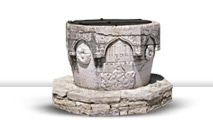
- Sečovlje Salt Pans - Dragonja River Valley
- Sv. Peter - Nova vas - Padna
- Pomjan - Nature Park: Karst Edge - Socerb
- Črni Kal - Osp - Kubed
- Momjan - Grožnjan - Pietrapelosa - Mirna
- Baštija - Kostanjica - Parenzana
- Oprtalj - Završje - Livade - Zrenj
- Istarske toplice - Motovun Forest - Višnjan
- Cave Mramornica - Feštini Kingdom - Cave Baredine
- Lim Bay - Kloštar - Kontija - Dvigrad
- Kanfanar - Bale - Palud - Vodnjan - Brijuni - Fažana
- Svetvinčenat - Tinjan - Pićan - Gračišće
- Belaj - Šumber - Kožljak - Paz
- Čepićko Field - Kršan - Boljun Castle - Lupoglav
- Plomin - Kvarner Gulf - Brseč
- Nature park Učka - Mošćenice
Baštija - Kostanjica - Parenzana
Kostanjica
The lower and middle course of the Mirna River were sailed transversally as well, which is testified by the transport activity of the Kostanjica inhabitants, known as the Kostanjica rafters.
The town was inhabited in prehistory. It was first mentioned in the 11th c. as Villa de Castan on the list of property offered to the Patriarchs of Aquileia. After the administration of the Devins and Counts of Gorizia, it was under the rule of the Habsburgs, and from the 16th c. under Venice. Written sources speak of it being purchased together with Završje at auction by G. Contarini, who kept possession of it until the 18th c. It was intended by the Venetians to have an auxiliary function in the defense of Završje. At the entrance of the town is a square with the parish church, reconstructed town loggia and belfry. The houses were built in the 18th and 19th cc. The Parish Church of SS. Peter and Paul dates from the 17th c., while the cemeterial church from the 12th c. is dedicated to St. Stephen.


















